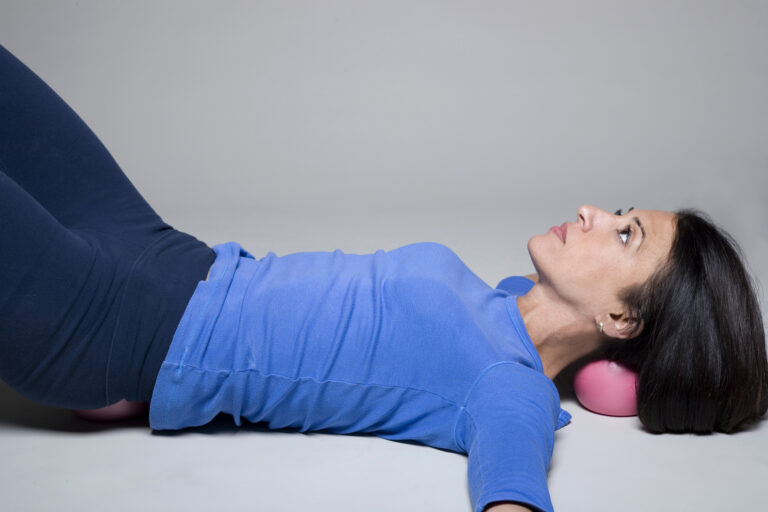It has been a passion of mine for many years to bridge the gap between the amazing experiences I get on the ball off the ball, and to develop a class that helps others do the same. I’ve been working toward this for decades and feel like I inch closer to bridge this gap.
It’s not that exercise is wrong — it’s the way people teach it.
Exercise needs to reflect how the body naturally functions. For example, clench your fist. In that state, you can’t use your computer, text, drive a car, or pick up a cup of coffee. On the flip side, if your hand is completely limp — as some modalities often encourage with “just relax, release, let go” — you still can’t do those things. Most of us have mistaken tension for a “bad” thing. In fact, it is very common for people in the classes to want” no” feeling. Tension is your best friend because you can adjust it if you know how. Exercise is using tension.
Muscle tension adjusts to where it connects all parts throughout your body to move freely.
The Miracle Ball Method can give your body the experience of a comfortable tension that reconnects you to the whole body. In many cases we interpret that easy feeling as no tension. That is understandable because the aches and pains seem to disappear. Clenching is no longer necessary when you allow your nervous system to re-introduce you to the way our bodies naturally align through our senses.
It’s experiential. As children, we move freely and intuitively because of a strong mind-body connection — something that often gets lost as we age, many experience a mind-body disconnection.
Reconnecting the mind and body is a beautiful experience on the ball. People often describe a powerful sense of joy and release — and I don’t underestimate that. But wouldn’t it be great to translate that powerful feeling into how we move off the ball — in everyday life and in traditional exercise classes.
It seems to me that when your breathing starts to move into different parts of the body — and you acknowledge those parts with your Body Dialogue — it only makes sense to take what I call the Body Dialogue with you into your day.
“Oh, I love that feeling of breath in my rib cage. I feel how my ribs begin to move freely when I’m not holding my breath.” When you acknowledge with clarity you are teaching or reconnecting to your nervous system. It’s not so much an emotional feeling for the nervous system as adapting to a new way to move.
Recently, I taught a workshop combining traditional, effective movements from exercise classes with the Miracle Ball Method. What became clear:
You can’t separate the Method from the movement.
Exercise is movement, whether we label it Pilates, Yoga, or anything else. Most people carry excess tension in their bodies —without realizing. They don’t breathe as freely as they can, and this creates a cycle of pain. When you take that clenched body into exercise without the Body Dialogue— it can actually backfire. You’re reinforcing patterns that can cause pain, and in some cases, chronic injury.
Do It Differently
A daily Miracle Ball practice is essential to my life — and I hope to many who’ve worked with me. That doesn’t mean hours of effort. Even 10 or 15 minutes can make a difference. But it’s how we do it that matters. Liking or not liking what you are doing is different than discovering you must connect body to brain through a real physical feeling and reuse that language when you exercise and throughout your day when you are momentarily noticing some of the old habits returning that cause you difficulty or pain.
This is not an exercise program. It’s a way to bring your body — your instrument — back into tune.
Imagine that beautiful Steinway piano in your living room — the one that was dropped a bit while being moved. It still looks beautiful, but it doesn’t sound quite right. That’s your body when it’s out of tune. The Miracle Ball Method helps it sound beautiful again. And your nervous system, at any age, is capable of doing this.
Now, maybe you’re part of the small percentage of people for whom this makes no sense — you’ve never had an ache or pain. I’ve met a few like that. Once, an 87-year-old man came up to me in a hospital I worked at and said, “My back hurts.” Then he added that he’d never had any back pain in his life until that moment. I told him, “You’re my golden ticket!” (If you’ve seen Shark Tank, you’ll know what I mean — Lori Greiner gives the golden ticket to rare gems.)
But for the rest of us mere mortals, working through the nervous system is essential.
That’s what the Miracle Ball Method does.
It changes the narrative. It changes the dialogue. That’s why I call it “Body Dialogue” in the book.
It’s not complicated — but it is specific. You must begin to acknowledge what’s changed when you get off the ball, so you can take what you experienced with you.
If it’s just a great feeling — that’s wonderful. Maybe you don’t feel the need to carry it through your day. But for many of us, we do — especially if we’re dealing with chronic pain, old injuries, anxiety, or just want to move and feel better.


